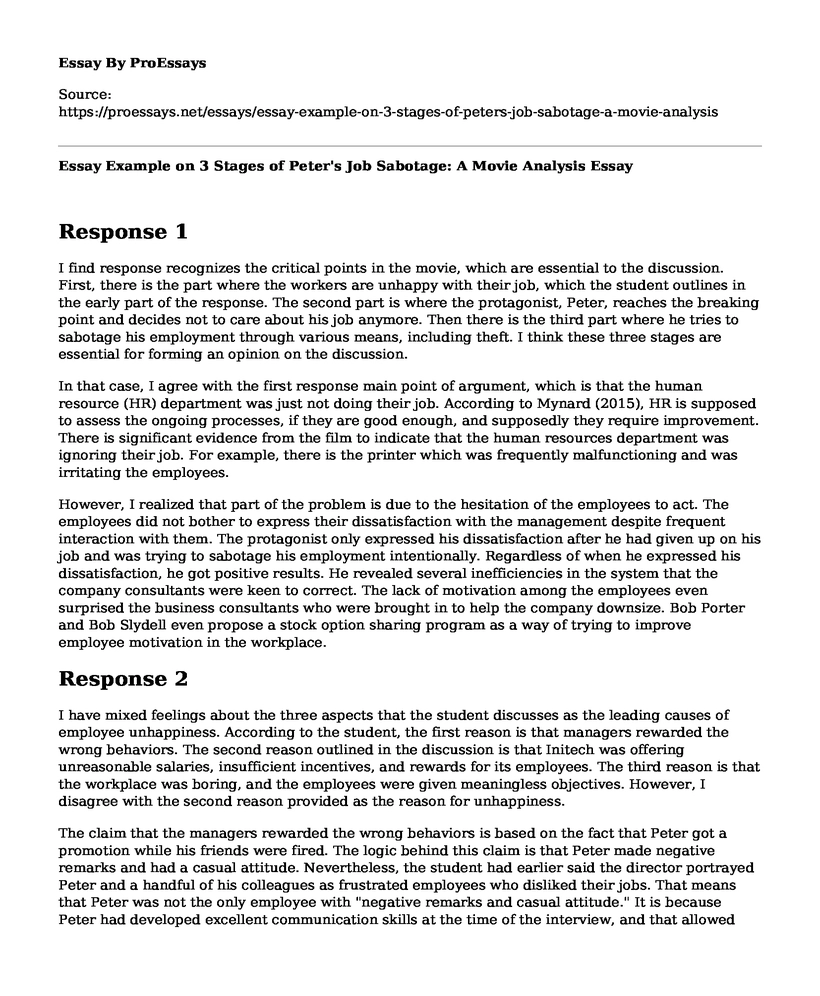Response 1
I find response recognizes the critical points in the movie, which are essential to the discussion. First, there is the part where the workers are unhappy with their job, which the student outlines in the early part of the response. The second part is where the protagonist, Peter, reaches the breaking point and decides not to care about his job anymore. Then there is the third part where he tries to sabotage his employment through various means, including theft. I think these three stages are essential for forming an opinion on the discussion.
In that case, I agree with the first response main point of argument, which is that the human resource (HR) department was just not doing their job. According to Mynard (2015), HR is supposed to assess the ongoing processes, if they are good enough, and supposedly they require improvement. There is significant evidence from the film to indicate that the human resources department was ignoring their job. For example, there is the printer which was frequently malfunctioning and was irritating the employees.
However, I realized that part of the problem is due to the hesitation of the employees to act. The employees did not bother to express their dissatisfaction with the management despite frequent interaction with them. The protagonist only expressed his dissatisfaction after he had given up on his job and was trying to sabotage his employment intentionally. Regardless of when he expressed his dissatisfaction, he got positive results. He revealed several inefficiencies in the system that the company consultants were keen to correct. The lack of motivation among the employees even surprised the business consultants who were brought in to help the company downsize. Bob Porter and Bob Slydell even propose a stock option sharing program as a way of trying to improve employee motivation in the workplace.
Response 2
I have mixed feelings about the three aspects that the student discusses as the leading causes of employee unhappiness. According to the student, the first reason is that managers rewarded the wrong behaviors. The second reason outlined in the discussion is that Initech was offering unreasonable salaries, insufficient incentives, and rewards for its employees. The third reason is that the workplace was boring, and the employees were given meaningless objectives. However, I disagree with the second reason provided as the reason for unhappiness.
The claim that the managers rewarded the wrong behaviors is based on the fact that Peter got a promotion while his friends were fired. The logic behind this claim is that Peter made negative remarks and had a casual attitude. Nevertheless, the student had earlier said the director portrayed Peter and a handful of his colleagues as frustrated employees who disliked their jobs. That means that Peter was not the only employee with "negative remarks and casual attitude." It is because Peter had developed excellent communication skills at the time of the interview, and that allowed him to express himself freely. White & Clement (2015) discuss clear communication as one of the main ingredients of employees understanding the operations of the company. It means Peter had a better understanding of the company functions and what needed to be done.
Strict HR policies to discipline office romance is not likely to work in favor of the company. There are certain risks involved with workplace relationships such as conflict of interest or complicated workplace relationships in case of a breakup. However, when you place grownups with feelings and emotions close to each other, for long hours, some of them will end up developing feelings for each other. As a result, it is better to have an open office dating policy so that the HR would not have to punish anyone for falling in love or being human. However, supervisors or those occupying managerial roles should have more stringent requirements that prevent conflict of interests.
References
Maynard, D. (2015). Employment law, employee relations, and healthcare. In B. J. Fried, & M. D. Fottler (Eds.), Human resource in healthcare (pp. 35-77). Health Administration Press.
White, R. K., & Clement, D.G. (2015). Healthcare professionals. In B. J. Fried, & M. D. Fottler (Eds.), Human resource in healthcare (pp. 79-106). Health Administration Press
Fottler, M. D. (2015a). Job Analysis and Job Design. In Human Resources in Healthcare: Managing for Success (4th ed., pp. 143-177). Chicago, Illinois: Health Administration Press.
Fottler, M. D. (2015b). Strategic Human Resource Management. In Human Resource Management in Health Care (4th ed., pp. 1-33). Chicago, Illinois: Health Administration Press.
Mike, J. (Director). (1999). Office Space [Film]. Twentieth Century Fox Home Entertainment.
White, K. R., & Clement, D. G. (2015). Healthcare Professionals. In Human Resource Management in Health Care (4th ed., pp. 79-106). Chicago, Illinois: Health Administration Press.
Cite this page
Essay Example on 3 Stages of Peter's Job Sabotage: A Movie Analysis. (2023, Apr 24). Retrieved from https://proessays.net/essays/essay-example-on-3-stages-of-peters-job-sabotage-a-movie-analysis
If you are the original author of this essay and no longer wish to have it published on the ProEssays website, please click below to request its removal:
- The Comparison of the Paintings by J.M.W Turner and Paul Cezanne
- Can Music Improve Learning?
- Social Media Passwords Being Requested in Interviews Essay
- Is Writing Beneficial or Detrimental to Learning? - Paper Example
- The War Room Essay Example
- Miss Evers' Boys and One Flew Over the Cuckoo's Nest Essay
- Symbolism in Mark Twain's Adventures of Huckleberry Finn - Essay Sample







